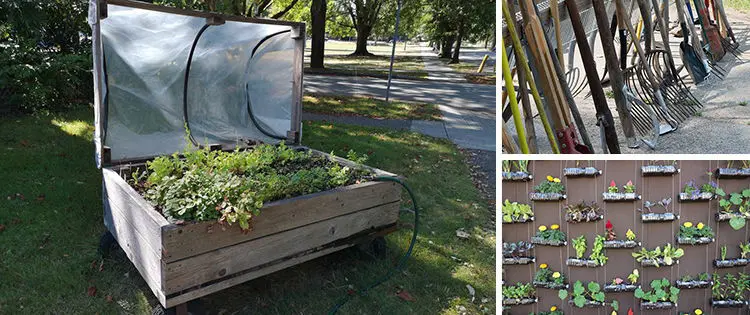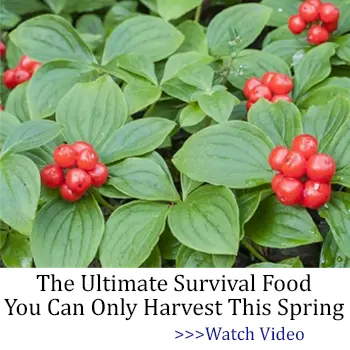Gardens are costly, however they don’t necessarily have to be.
From the tools we use to developing and increasing soil fertility, there are many ways to reduce overall costs.
Some of the ideas I have for you can even save you time, as well.
Shopping For Tools
Shopping for tools can add a lot to the overall cost of setting up a garden shed.
Opting for secondhand can drastically cut the costs. Some pawnshops have a section with construction tools on special.
You can also go to thrift stores to look for household-yard management and garden-oriented tools, but you should call and find out before you go there. Estate sales, flea markets, and yard sales are treasure troves as you can find spades and rakes to pruners and clippers.
When shopping for garden carts or wheelbarrows and watering cans or cultivators, scan the material list for anything you’re building, and be open to suggestions. Pre-owned levels, carpenter’s squares, step ladders, and somebody’s can of screws and nails can drastically reduce the purchase bill.
Rotten electrical cords and high-test fishing lines can form plant ties and trellises, or you can use them as frost blankets. Loose-woven curtains can be used as bug barriers – and horse work as drip irrigation lines or row cover supports, further chipping off the cost of upgrades, expansions, and builds.
Related: 26 Necessary Tools For Off-Grid Living
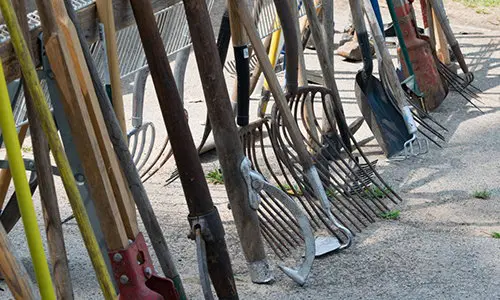
Mulches
Mulching helps us a lot, making crops, soils, and our valuable time more productive. Various types of mulch accomplish different things – the good thing is that there are free and cheap options available for everyone.
You can get shredded newspapers from recycling bins, cardboard from appliance or liquor stores to act as weed exclusion barriers for both walkways and rows. Grass clippings are also excellent weed barriers as they can form dense mats over the soil. I usually use them around perennials because of the seed heads, but other homesteaders successfully use them in their gardens. Make sure you poke them with a garden fork because, like shredded office paper, the mat solidifies and creates an irrigation/rain barrier and anaerobic conditions.
If you’re looking to lower evaporation or irrigation – chipped wood, pine needles, and straw leaves work very well. Before you buy bagged bulk mulch or straw, check out alternatives like a flake and shredded animal bedding.
The pine bedding is less likely to have big chunks or odd bits of painted furniture left in it. It’s usually animal-safe and heat-treated, making it great for people against chemicals in their gardens. It’s light, less messy, less attractive to ants and slugs, and eliminates the big chunks that poke holes in the package.
Related: 40 Uses For Sawdust Around Your Homestead

Free Fertilizers
You can make compost and leaf mold in any yard size, even without turning to tumble bins, worm towers, or keyhole gardens that can accelerate the composting process.
Gather leaves from around your yard and toss them in a bag for 3-12 months, and you got yourself rich organic matter filled with nutrients to serve as a powerful soil amender or mulch. You can also compost by digging a trench in your garden then covering it as you go.
There are many ways to boost the fertility of your garden. You can add tea or coffee at the surface of your planters or pots or plants out in large plots. You can also use leftover brewer’s mash even though it has a bit of a smell. Algae is the king of nutrients, so collect it and spread it in your garden.
Related: The Ultimate Guide To Composting
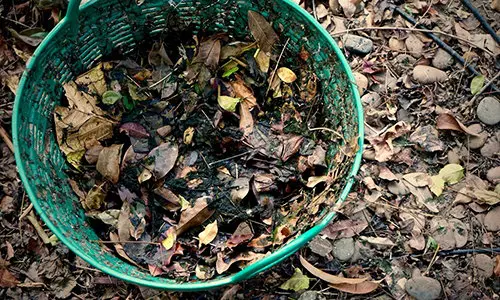
Online Searching
I can get different types of garden materials without paying anything.
Keep a close eye on yard sales because, at the end of the day, most sellers are open for heavy discounts, and there’s a chance you’ll get something for free.
Different types of furniture fall apart – and I use them as stakes or beds. You can also use clothing, curtains, and blankets as mulch, and you can repurpose tubing and hoses or specific tools for building, maintaining veggies, or breaking ground.
Old bikes, mattress springs, and bed frames can become fencing or trellises. Bathtubs, totes, and sinks can be rain “barrels” or planters, shoe and clothing organizers, laundry baskets, bookcases, cookie jars, lampshades, and surprisingly boots can also serve as planters.
The internet has everything you need. If you can’t find something, look for a similar-shaped item.
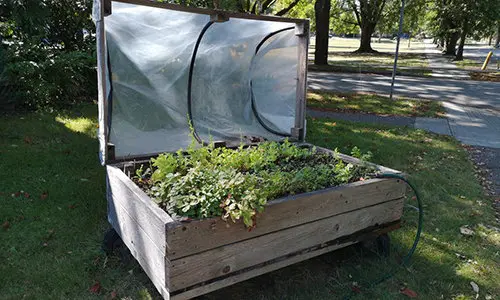
Garden Prizes
While upcycling, remember to look for broken goodies and recycling bins that you can use for something else. Busted lamps and hollow bed frames can be used as water tubes for sub-irrigated planters – plastic bottles work just as well.
There are lots of ways to transform former food containers into irrigation assists and small garden containers for greens, strawberries, herbs, peas, and companion flowers.
You can use virtually anything to plant in – that goes from badly worn jeans to puppy-chewed wicker blankets. Blankets, tattered clothes or towels, and curtains can all work as weed exclusion in your garden or keep mosquitoes out of your water catchment, to provide shade or frost protection, or serve as water sinks and wicks for our beds and planters.
Related: Ingenious Ways To Recycle Plastic Bottles
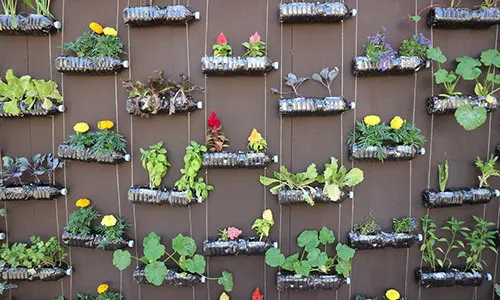
Achieve More
There are a lot of things to spend when it comes to preparedness. To start, maintain, and expand a garden is just one part of what draws our time and finances.
From the garden equipment and tools to soil amendments, adopting frugality can ease some of the inputs required to produce more groceries at record time while staying on budget.
These solutions may seem impossible to some, but often there’s a cheap fix. Learning to see things differently and purchasing cheap items has other advantages. International issues alter supply lines. Using anything you have to achieve your goals is a skill that is handy during a crisis.
These are a few strategies you can use in your garden, from freebies to secondhand shopping. Before buying anything, research how others are cutting costs on the same project.
You may also like:
If You See This Plant in Your Backyard, Burn It Immediately! (Video)

